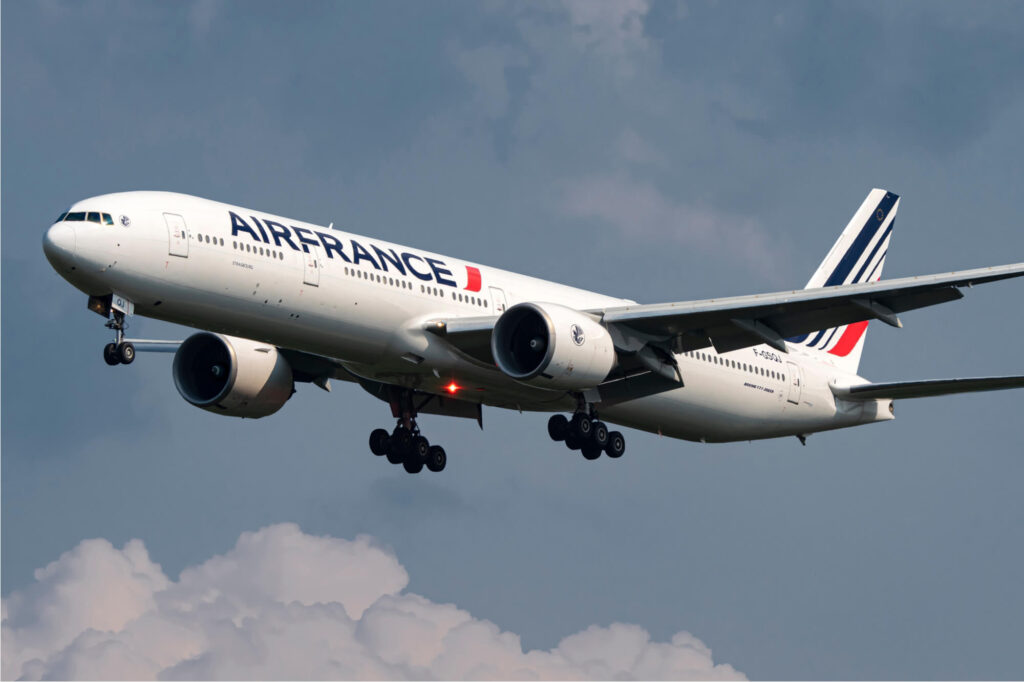French investigators have released details showing how Air France pilots were making opposing movements to control their Boeing 777 aircraft during a serious incident while landing in Paris.
The Air France 777-300ER, registered F-GSQJ, was carrying out flight AF011 from New York-JFK (JFK) to Paris Charles de Gaulle (CDG) on April 5, 2022 when the pilots broke off the approach.
The pilots reported to air traffic control that the plane was unresponsive to controls. In ATC audio published online, the crew can be heard struggling and calling “Stop, stop,” while warnings sound in the flight deck.
The Bureau d’Enquêtes et d’Analyses (BEA) released an update into the investigation on April 27, 2022. The update explains that the aircraft was functioning normally and that, so far, the control inputs made by the pilots match with what the plane did. However, the data shows both pilots making opposing movements of the controls during the go-around procedure.
“No anomaly was observed on the aeroplane,” the update states. “At this stage, the analysis of the parameters does not show inconsistencies, in particular between the movements of the controls and the movements of the aeroplane.”
AeroTime columnist and pilot Captain Michel Treskin commented that the update shows there was no problem with the aircraft but does paint a scene of confusion in the flight deck.
“It’s very difficult to assess controllability problems when you have two pairs of hands on the controls trying to do different inputs,” Captain Treskin explained. Investigators will likely look into whether fatigue and training played a role as they analyze the incident further, he added.
What exactly happened?
The incident started at 07:50:20 UTC when the aircraft, with 15 crew and 177 passengers on board, was on approach to runway 26L at CDG. The first officer was the pilot flying and at an altitude of 1,670 ft, he disconnected the autopilot to perform the approach manually.
Less than a minute later, the first officer “expressed his astonishment” regarding the plane’s bank angle. The aircraft was turning left with a small bank angle, matching the inputs made by the pilot. The Captain also seemed surprised at the deviation from the flight path.
At 07:51:12, when the aircraft was at an altitude of 1,115 ft, the crew decided to perform a go-around. At that point, investigators noted, the 777 was banked 7° to the left, with the yoke also turned to the left. However, the approach was still within the criteria for a “stable approach” at that point, meaning the pilots could have continued the approach.
During the go-around, the confusion seemingly increased, with the pilots battling each other on the controls of the Boeing. In multi-crew aircraft, one pilot’s role is to fly the aircraft and make the relevant control inputs (pilot flying), while the other monitors the flight path, aircraft and handles communications (pilot monitoring)
During the go-around on the Air France flight, the captain was making nose-down inputs, while the first officer was pulling back on the controls. In addition, within one second of the go-around, the control wheel moved more to the left and the aircraft banked more to the left.
It took until 07:52:06, for the captain to become the only person making control inputs. The update did not make mention of whether the captain called that he was taking control of the aircraft. It is standard practice to call “I have control” to indicate who is in control and flying an aircraft.
Source: BEA
The repeated control inputs also led to the “push-to-talk” and autopilot disconnect switches being pressed inadvertently, investigators said.
“The sustained input on the controls led to the PTT button and the AP disconnect switch being involuntarily pressed, the latter action causing several activations of the associated warning,” the BEA said.
After completing the go-around, the crew analyzed the situation and then performed a landing on runway 27R without further incident.
Investigators will continue their analysis, with focus on the forces on the controls and how these forces corresponded to the movement of the controls.

